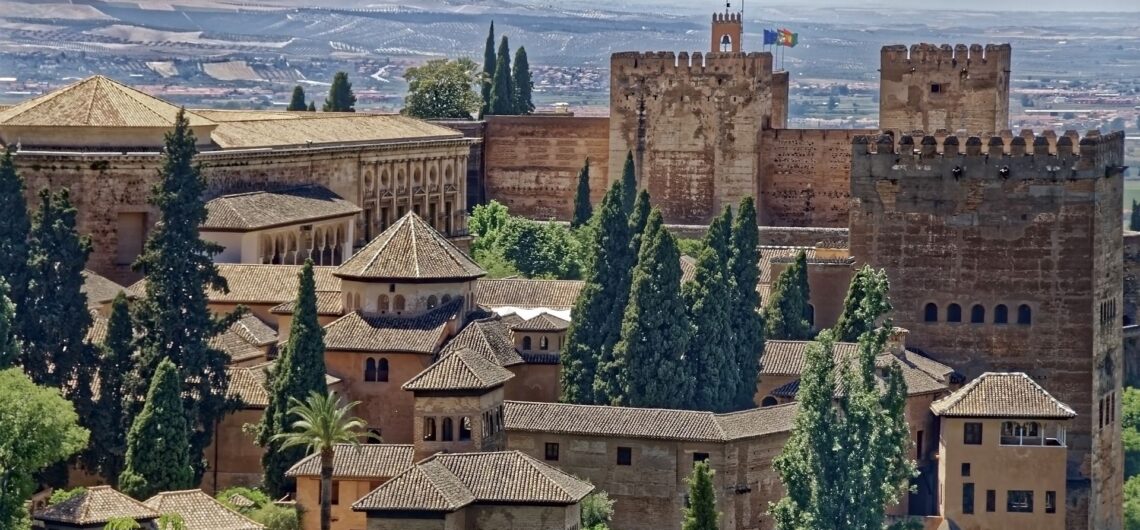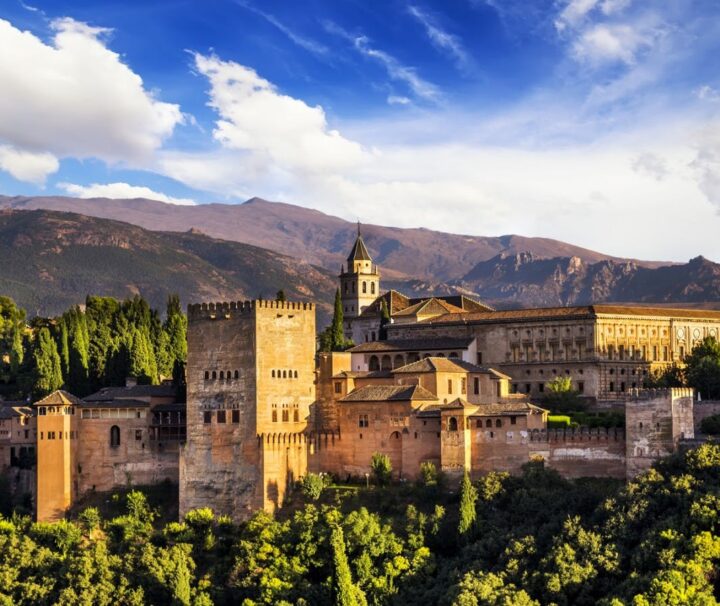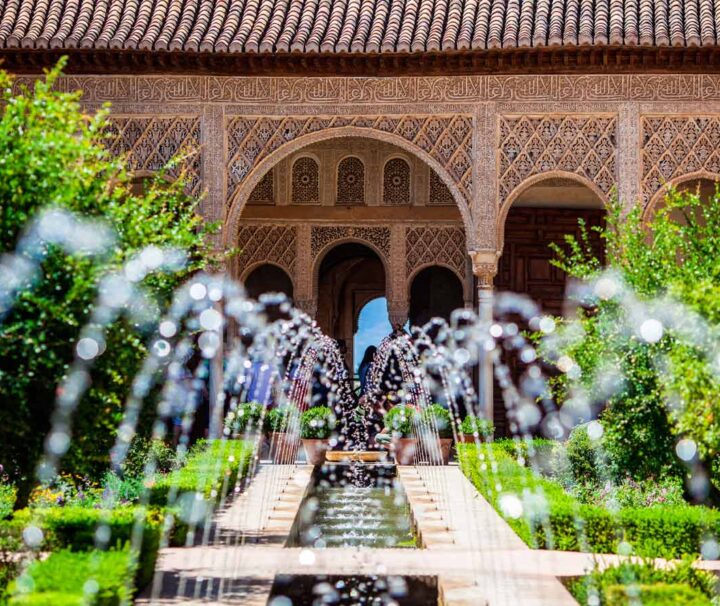Reading the Alhambra
Chapter 5
Based on a transcript from the documentary: Reading the Alhambra. In this final posting, we go deeper in reading the more complex kufic scripts and the combination of it with cursive writings.

The Nazareth motto “wala Ghalib illa Allah – There is no Victor but God” which it said was taken by the first Nazareth caliphs from the standard raised by the almohads sultan al-Mansur at the Battle of Alarcos; whilst it´s typical version in cursive script is ubiquitous throughout the Alhambra, inscribed in phrases both short and long on surrounding arches and windows, painted on wooden cornices and running along the tops of walls.
Its Kufic counterpart forms interesting calligrams in many corners. Here in the pendentives of the Hall of the Two Sisters, creating a tripartite portico.

In the arches above the entrance into the Halls of the Abencerrajes and the Two Sisters, the motto is at the center of a delightful triple arch accompanied by ‘Barakah’.

And on the entrance to the Mirador of Lindaraja, the calligraph changes subtly with ‘Allah’ forming the base and the rest of the design being completed with plaits arches and foliat motifs.

Again, we can see it in the Partal Palace. A singular composition begins with the first half of the motto ‘Wala ghalib’ in broad Kufic lettering forming two stylised trees and the second half ‘illa Allah‘ is smaller Kufic script tracing scalloped compostion which is repeated twice in each panel.

Frequently, the calligrams are not isolated but are repeated to form rows of false arches or porticos. In the mihrab of the Partal obituary, two calligrams are combined “God provides in all adversity” develops into 3 architectural levels, housing foliat elements and an upper cartouche in which it is written “praise be to God for the bounty of Islam“. Next to it, another calligram containing “sovereignty belongs to God” forms a similar structure containing other expressions in cursive script. Their repetition creates the illusion of a gallery within the mihrab itself.


Perhaps, the most complex single calligram is to be found inscribe within the central tympanum in the Mirador of Lindaraja.

It comprises the sentence “glory be to our Lord the Sultan“, “may God sustain his authority and perpetuate his felicity” from which derives an intricate structure housing stylised trees and three expressions written in cursive scripts.
To the right, “praise be to God for the bounty of Islam“; to the left “praise be to the one God” and then “thanks be to God” and in the middle “God is the best protector and he is the most merciful one. God the highest has spoken the truth“.

The combination of Kufic and cursive epigraphs with other elements sometimes forms highly symbolic labels such as those in the archives of the North Portico of the Courtyard of the Myrtles where a series of architectural calligrams of “perpetual happiness” runs along elegant dadoe of tiles that imitate the swell and flow of water.

These are flanked by pairs of small columns which support the Mocarabes of the cornice of which it is written “Yuum – good fortune” repeated in mirror images and “glory be to our Lord Abu Abdallah“, thus creating a stucco portico inwards which together with the impression of water given by the tiled background reproduces in two dimension, the architecture of the courtyard itself, complete with garden and ornamental pool.
And, above it, it´s a frieze of Nazareth mottos gives rise to another containing royal shields surrounded by the same motto and above these more complex architectural calligrams composed of the Quranic expression “victory only comes with God the powerful the wise” forming a base for the vault of Mocarabes, amongst which are written in Kufic script “God Provides” and “Barakah“. If you gaze at these calligrams rising up from the surface of the undulating tiles, you will be aware of how they become an enticing architectural illusion before your eyes.

Eventually, the decorative lines of the arches included within themselves inscriptions and calligrams creating beautiful highly complex designs in which the Kufic inscriptions act as a basis to generate the geometric patterns and in this way the word becomes the origin of the decorative universe the creative womb of the world.

Thus, in the Hall of Comares, an extensive panel of inter woven arches in the product of a combination of calligrams of ´al-mulku li-llahi -soverneighty belongs to God´ with ´li-llahi´ at the bottom and ´barakah´ repeated upwards joined by a series of scalloped arches which in turn are interspersed with another of plain round arches.

And, in a panel characteristics of the Palace of the Lions, ‘Barakah’ repeated in mirror image creates a base to support a series of intertwine calligrams ‘God provides in all adversity‘, where these stretches cross decorative strands, you can read the exclamation ‘al-´izzatu li-llahi – Glory belongs to God‘, filling all the gaps and spaces dense foliat and floral motifs complete a vividly rich and intensely rhythmic picture.


To read and feel the Alhambra is therefore to enter into a magnificent garden book in which the architecture written and constructed in words, emanates from the spring of classical Arabic poetry and the creative world never has architecture being so communicative and poetic as it became in the hands of the Nasrid builders and never have words and poetry been embodied in architecture with such subtlety and intensity as Alhambra.
As exciting as it is the postings are, giving us a basis on understanding the inscriptions of the Alhambra, nothing can compare to be there physcially, surrounded by it all. Step into Alhambra and embrace its wealth of wisdom.
Note: All text and images are from the documentary of ´Reading the Alhambra´ except stated otherwise.
You may also like check our videos
Youtube
Alhambra Spain (Andalusia) Muslim Tours
Andalusia Muslim Tour 6 Days - 590€
Alhambra Muslim Tour



